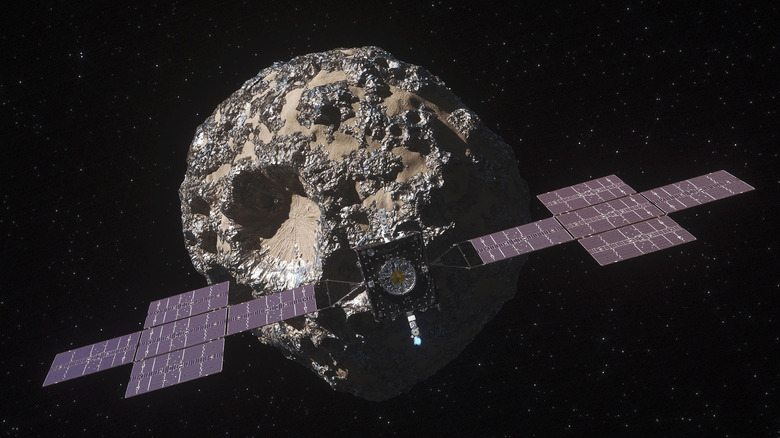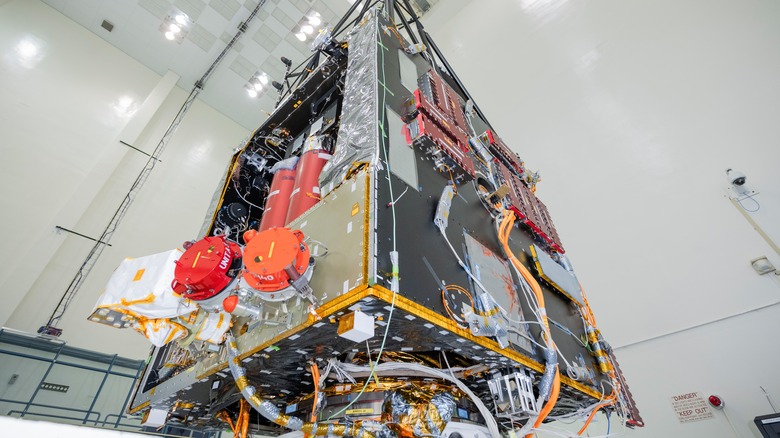Why NASA's Exploration Of This Metal-Packed Asteroid Could Have Big Implications
NASA will soon launch a spacecraft on a six-year journey to visit Psyche. This strange rare metal-rich asteroid is different in its composition from most other objects in the main asteroid belt between Mars and Jupiter, which are composed primarily of a mixture of rock and smaller amounts of metal. The mission will launch on Thursday, October 12, from NASA's Kennedy Space Center in Florida, traveling around 2.2 billion miles to reach its target.
The spacecraft will go into orbit around Psyche and study it using instruments like a gamma-ray and neutron spectrometer, a multispectral imager, and a magnetometer. The asteroid seems to be made almost entirely of nickel and iron, making it unique in the solar system. That means that it could be key to understanding how objects like our planet formed in the early solar system.
"What makes Psyche and the other asteroids so interesting is that they're considered to be the building blocks of the solar system," said Tracy Becke of the Southwest Research Institute, lead author of a study published in the Planetary Science Journal on Psyche's composition. "To understand what really makes up a planet and to potentially see the inside of a planet is fascinating. Once we get to Psyche, we're really going to understand if that's the case, even if it doesn't turn out as we expect. Any time there's a surprise, it's always exciting."
Why study asteroids?
Scientists are interested in studying asteroids because they can help uncover how the solar system formed and evolved. Here on Earth, processes like plate tectonics mean that rocks are recycled over time, so there are few rocks older than around 4 billion years old that can be used for research. But it's thought that the solar system is older than that, forming around 4.5 billion years ago. To understand this early period of planetary formation, scientists need clues that they can't get on Earth.
That's where the interest in asteroids comes in. Many of the asteroids in the solar system, like those in the main asteroid belt, are thought to be left over from the early formation of the rocky planets. These clumps of rock are therefore pristine samples of what kinds of materials were hanging around when the planets formed.
Asteroid Bennu, for example, from which NASA recently brought back a sample, is thought to be around 4.5 billion years old. Studying asteroids like this can therefore show what the solar system looked like when Earth and other planets were only just beginning to form, giving a window into processes that we can't learn about from only studying our own planet.
What makes asteroid Psyche so intriguing
Psyche isn't just any old asteroid though: its unusual metal composition marks it out as something special. One theory is that it is the core of a forming planet, called a planetesimal, which was interrupted in its development. The idea is that, like Earth, Psyche was forming into a rocky planet with a metal core. But then Psyche was struck by a large impact, such as from another asteroid or a comet, which knocked off its rocky outer layers. What remains is only the metallic core. Therefore, studying it can help us understand the metallic core of Earth which we can't reach to study directly.
However, there's also something off about Psyche as rocky planets like Earth and Mars have rocks on their surface that contain iron oxides, but Psyche doesn't. So maybe Psyche developed differently from these rocky planets and is a different kind of object, unlike anything else in the solar system. One way in which the Psyche spacecraft will investigate the asteroid is by using its magnetometer, which is an instrument that can detect magnetic fields.
It will look for evidence of leftover magnetism, as finding that there was once a strong magnetic field around the asteroid would help support the idea that the asteroid was once a planetary core. Its other instruments include a spectrometer which can look at what elements the asteroid is made up of and confirm whether it really is mostly metal, and reveal the exact mix of elements which can help show how it formed. Finally, the imager will take pictures of the asteroid to show any features on its surface.
Bonus science on the Psyche mission
As well as studying this unique metal asteroid, the Psyche mission will be a testing ground for some new technologies as well. To travel on its long journey to the asteroid belt, Psyche will use a solar electric propulsion system that uses the sun's rays to create electric and magnetic fields which pushes xenon gas out the back of the engines, driving the spacecraft forward.
This is an extremely efficient system which is often used by satellites. Most deep space missions use chemical propulsion instead, but the efficiency of the electric propulsion method will help carry the craft on its long journey without needing too much fuel.
"Even in the beginning, when we were first designing the mission in 2012, we were talking about solar electric propulsion as part of the plan. Without it, we wouldn't have the Psyche mission," said Psyche principal investigator Lindy Elkins-Tanton of Arizona State University via JPL. "And it's become part of the character of the mission. It takes a specialized team to calculate trajectories and orbits using solar electric propulsion."
In addition, Psyche will also carry a communications test called Deep Space Optical Communications (DSOC) which will use lasers to transmit information back to Earth. The idea is to increase the bandwidth of communications, which will allow future missions to send back more information from their instruments. The test will be performed for the first two years of the mission, sending data from distances of up to 240 million miles (390 million kilometers).

